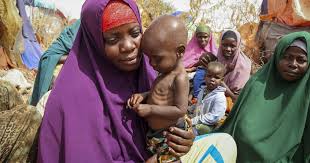Somali Magazine – Approximately 4.3 million Somalis are at danger of acute food insecurity, while 1.5 million minors face acute malnutrition. The crisis is likely to strike Somalia between October and December 2023 as a result of a combination of circumstances, including the negative effects of El Nino-related severe rains and flooding, as well as a projected drop in humanitarian aid in the next months due to funding restrictions.
This is an increase in the number of persons facing crisis (IPC Phase 3) or worse outcomes from 3.7 million between August and September 2023. An additional 5.6 million individuals are stressed (IPC Phase 2), raising the total number of persons experiencing acute food insecurity (IPC Phase 2 or higher) to 9.3 million.
The IPC report shows that most of the pastoral and agropastoral livelihoods of the northern and central regions, southern Somalia, and riverine livelihoods in Hiran, Middle Shabelle, Lower Shabelle, and Gedo are classified as in crisis (IPC Phase 3).
Parts of the Southern Inland Pastoral of Galgadud, Hiran, Bakool, Gedo, Middle Juba, and Lower Juba, the Southern Cattel Pastoral of Middle Juba and Lower Juba, and the Southern Rainfed Maize Agropastoral of Lower Juba appear stressed (IPC AFI Phase 2).
Despite the high intensity of the 2023 rains, catastrophic flash floods have occurred, causing major damage in portions of Gedo, Bay, and Bakool, as well as parts of the northwest regions, and causing population displacement, crop losses, and market access problems.
Places like Lasanood district, where ongoing conflict has displaced thousands and disrupted livelihoods and market access, will see both IDPs and urban populations face large food consumption gaps and remain in emergency (IPC Phase 4).
Flooding and subsequent population displacement, disruptions to livelihoods and market access, disease outbreaks, and reduced access to health services are expected to worsen food security outcomes among Beletweyne IDPs (IPC Phase 3 to IPC Phase 4) and Beletweyne Urban (IPC Phase 2 to IPC Phase 4).
Food security outcomes are also expected to deteriorate among IDPs in Baidoa and Kismayo (IPC Phase 3 to IPC Phase 4) due to multiple factors, including reduced access to humanitarian assistance and disease outbreaks. Most other urban populations will remain in crisis (IPC Phase 3) or stressed (IPC Phase 2).
Somalia has been hit by a slew of disasters, making it difficult for people to cope with their daily lives. Following a prolonged drought in Somalia, a fresh catastrophe (heavy rains) has struck the country, destroying millions of hectares of land after being swamped by flood waters along both the Juba and Shabelle rivers.
A year after a prolonged drought, Deyr rainfall has killed around ten people and displaced more than 113,000 people.

